


About Me
About Me
About Me
About Me
Chrisoula Toupadakis Skouritakis
Education:
- B.A.S. Biological Sciences and Art Studio, 2005 UC Davis
- Ph.D. Molecular, Cellular and Integrative Physiology, 2012 UC Davis
I am a physiologist, researcher, illustrator, and educator.
I live in Davis, CA and work part-time as a researcher at the University of California, Davis, and part-time as a freelance biomedical and scientific illustrator. In the past, I have taught anatomy and physiology at the university level.
I specialize in figures for scientific, medical, academic, and educational literature.
My other interest is in educational research to discover more effective ways of teaching anatomy and physiology through visual and haptic communication in 2D and 3D.
My research experience and doctorate degree make me uniquely suited to creating illustrations for peer-reviewed journals.
I also have extensive experience with cadaver dissection, lab animal surgery, histology, traditional media, fine art, and ceramic sculpture.

Philosophy
Philosophy
Philosophy
Philosophy
I have always been equally enamored by both science and art. In my mind, they are inseparable; you cannot effectively have one without the other. Not being able to choose between them in college, I double majored in Biological Sciences and Art Studio with the intent to become a veterinarian. Instead of veterinary school, I ended up getting my doctorate in physiology (my favorite subject) while also taking additional anatomy classes. After teaching physiology and anatomy at the university level for a few years, I realized that what interested me was not the teaching itself, but discovering methods to more effectively communicate scientific ideas through visual means, i.e. diagrams, models, etc.
My interest is in communicating information in the most clear and concise manner possible, in order to aid learning and make it a quick and painless process.
This skill is just as important in scientific literature as it is in the classroom. If your figures are clear, concise, and easy to understand, your paper will be read and cited more often.

Published Works
Published Works
Published Works
Published Works
Published Illustrations:
- Park, S, Taylor, K, Zwingenberger, A, et al. 2015. Gross anatomy and morphometric evaluation of the canine lacrimal and third eyelid glands. Veterinary Opthamology.
- Amanatullah, DF, Antkowiak, T, Pillay, K, et al. 2015. Femoroacetabular Impingement: Current Concepts in Diagnosis and Treatment. Orthopedics. 38(3):185-99
- Yellowley, C. 2013. CXCL12/CXCR4 signaling and other recruitment and homing pathways in fracture repair. BoneKey. 2(3)
- Rathi, P, Periera, G, Giordani, M, et al. 2013. The Pros and Cons of Using Large Femoral Heads in Total Hip Arthroplasty. American Journal of Orthopedics. 42(8):E53-9
- Skouritakis, C.A.T. 2012. Stem Cells in Bone Repair: An Investigation of Homing and Mobilization. University of California, Davis. (Doctoral Disseration)
- Griffiths, LG, Fransioli, J, Chigerwe, M. 2011. Echocardiographic Assessment of Interventricular and Intraventricular Mechanical Synchrony in Normal Dogs. J Vet Cardiol.13(2):115-26
- Griffiths, LG. 2010. Surgery for Cardiac Disease in Small Animals: Current Techniques. Veterinary Clinics of North America, Small Animal Practice: Topics in Cardiology. 40(4):605-622

